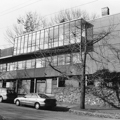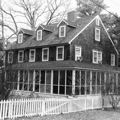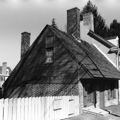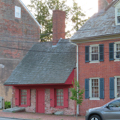Greenville socialite Mary Wilson Thompson was proud of having designed her own house at the beach, Mon Plaisir. This talented woman left her stamp on Delaware's architecture by overseeing construction of several homes of her own and helping preserve important buildings, including New Castle's Dutch House and Wilmington's Bank of Delaware. She shaped the physical landscape, too, by promoting anti-mosquito campaigns. Working in her Rehoboth Beach garden, Thompson had to wrap newspaper around her ankles to ward off bites. This would not do, so she agitated for control efforts, first working with a local women's club, then with town officials, and finally (1933) with Governor Buck in establishing Civilian Conservation Corps (CCC) ditchdigging camps at Lewes and Slaughter Beach.
In Delaware as elsewhere, the architectural profession has long been dominated by men, but women have been active, too—including, most prominently, Victorine Homsey, who along with her husband and partner, Samuel, designed several buildings in this book (see Homsey Architects). As early as 1892, Philadelphia architect Minerva Parker Nichols created Wilmington's New Century Club. Mary Craig, an architect of Santa Barbara, California, designed a Mount Vernon replica called Dauneport on Old Kennett Road, Christiana Hundred (1932–1933), as a home for Amy du Pont. In progressive Arden, the school (1945–1947) was built by Frances Harrison, a local woman architect.
Recent years have seen many more women practicing in Delaware, including Marjorie Rothberg. But one does not have to be an architect to influence the built environment, as Mabel Lloyd Ridgely proved in early-twentieth-century Dover, tirelessly advocating Colonial Revival and fending off modernism. Women's groups, including the Colonial Dames and the Junior League, have likewise lobbied for preservation.
Early in the twentieth century, du Pont women played a key role in laying out the elaborate gardens that made the Brandywine Valley one of the horticultural capitals of the country. In this, they were assisted by New York or Philadelphia professionals, including Marian Cruger Coffin, Ellen Biddle Shipman, and Annette Hoyt Flanders. They also funded historic preservation in Delaware and other states, with Jessie Ball du Pont (see Nemours) and Louise du Pont Crowninshield (see Eleutherian Mills) achieving national recognition.
Writing Credits
If SAH Archipedia has been useful to you, please consider supporting it.
SAH Archipedia tells the story of the United States through its buildings, landscapes, and cities. This freely available resource empowers the public with authoritative knowledge that deepens their understanding and appreciation of the built environment. But the Society of Architectural Historians, which created SAH Archipedia with University of Virginia Press, needs your support to maintain the high-caliber research, writing, photography, cartography, editing, design, and programming that make SAH Archipedia a trusted online resource available to all who value the history of place, heritage tourism, and learning.











